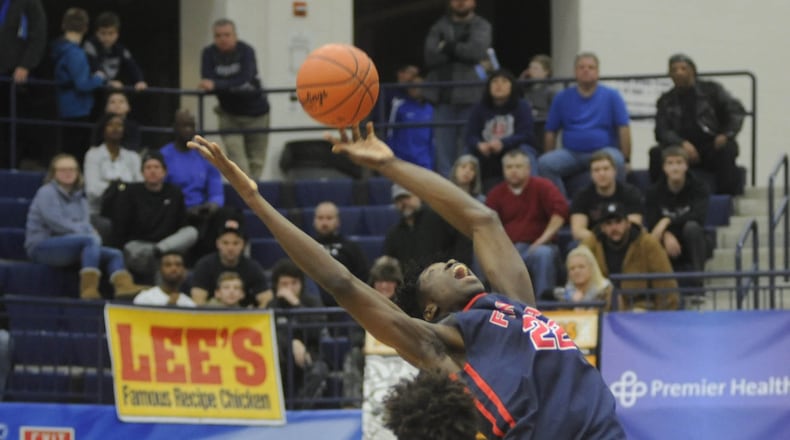The OHSAA constitution prohibits high school athletes from signing endorsement deals, but that could change May 16 if the organization’s membership votes to amend bylaws to allow athletes in the state to profit off their name, image and likeness.
The proposal was surprising and appears to be part of a “sea change” in athletics — perhaps to avoid lawsuits — after a similar NCAA 2021 policy, said Kendall Goodrich, a Wright State University business and marketing professor.
If approved in Ohio, Goodrich said, interest may be limited to local or regional businesses unless an athlete with rare talent — such as the NBA’s LeBron James or Luke Kennard, both native Buckeyes — comes along.
One regional restaurant which has deals with Ohio State University and the University of Dayton said if the issue is adopted, the business doesn’t plan to act quickly, noting the concept is “still so new.”
Centerville boys basketball coach Brook Cupps agreed the issue has to be dealt with sooner or later as other states have already passed similar legislation or are considering it.
“It’s something that’s going to happen, and it’s just a matter of how,” Cupps said. “I think we’re best served to be out in front of it and put ourselves in a situation to help our athletes, help our players handle it as well as they can handle it.”
‘We want to try to get ahead of this’
According to Opendorse, a Nebraska-based company that has tried to position itself as a leader in the amateur athlete endorsement industry, 10 states have legalized endorsements at the high school level while Ohio is one of 13 where name, image, likeness proposals are under consideration.
Northeastern Superintendent John Kronour shared the sentiment that changes could be thrust upon the OHSAA if it does not adopt its own.
“We’re better off if we are making our rules for our schools than being mandated to do something from a legislative perspective,” said Kronour, a former coach and athletics director who is still a game official. “I appreciate the referendum item, and we’ll see where schools fall on the vote.”
In a presentation at Northmont High School in April, OHSAA director of compliance Kristin Ronai explained the potential changes to athletic department representatives from around the state ahead of a voting period that will run from May 1-16.
“We want to try to get ahead of this,” Ronai said after noting college athletes have already been granted such rights in Ohio and a Supreme Court opinion expressed doubt about the legality of the NCAA denying them in a related case against the governing body of major college sports last year.
“We believe if name, image and likeness is going to enter the interscholastic landscape, we want to be the ones that are doing it,” she said.
If passed, the provision would allow athletes to enter into endorsement deals without compromising their eligibility, but there would be restrictions. Those include being barred from using their school name, logo or other trademarks in advertisements and engaging in marketing or endorsement activity during official team activities. Promoting casinos, gambling, drugs, alcohol or tobacco also would be prohibited, and deals must be for an individual, not an entire team or a representative of the player.
Public vs. private schools
Alter Athletics Director Christina Hart, who is also the co-head coach of the defending state champion girls basketball team, said she appreciates the association wanting to avoid future legal issues, but she opposes the notion of student-athletes getting endorsements.
“I’m probably going to kind of be in the minority in a sense,” she said. “I don’t think it’s a good idea at all. I think the rich are going to have an opportunity to get richer, and other districts are going to fall further behind. They’re going to have a more difficult time competing, I think.”
She’s concerned name, image, likeness opportunities could benefit private more than public schools.
“For a private school especially, there’s a lot of opportunity with alumni and boosters and supporters who have either connections or are affluent themselves and are able to provide basically an income for high school kids,” Hart said. “And let’s face it, they’re kids. They’re not really ready for something like this. I’m not sure that until you’re a sophomore, junior, senior in college that you’re really ready to handle something like this.”
High-profile transfers already occur, and that is far from simply a public/private school issue.
However, Northmont Athletics Director Micah Harding noted an aspect of the OHSAA’s transfer rules could make a big difference in the potential impact of endorsements becoming a reality.
Going from public school to public school requires a change of residence — which could be more expensive than the value of the type of endorsement deal most players could expect to realistically sign — but going from a public school to a private school does not.
“That’s also been something that’s come up when I talked to other athletic directors as far as the rich getting richer,” said Harding, who is the president of the Southwest Ohio Athletic Directors Association. “Those schools already can draw kids from a 45-mile radius or whatever, right? Why can’t they now say, ‘Well, yeah, come here, get that private school education, play high competitive sports and a better opportunity to make money and you don’t have to move.’”
Such a recruiting pitch would still be against the rules, but Hart acknowledged those types of conversations could go on even without the school knowing.
“A lot of kids would love to come to a private school, but their parents can’t afford the tuition,” Hart said. “So now, how does that translate? Do they get to make a deal that’s going to help them or either pay the entire tuition or a good portion of it?
“I would hope that there would be some kind of a cap or a limit, and that there would be pretty stringent rules around it,” she added. “And I would also think it’s probably going to be a work in progress, just like so many of the OHSAA’s rules and regulations. They’re constantly being tinkered with as everybody tries to figure out what’s best.”
OHSAA Executive Director Doug Ute told this news organization that recruiting already being against the rules should be stressed in these discussions.
Like others, he suggested relatively few athletes — perhaps 50 statewide — would be candidates to cash in on their fame from playing sports.
“It just comes down to everything is so new that it’s just really hard to speculate,” Ute said. “I don’t believe that this will be widespread and a lot of kids start making money on their notoriety because there’s got to be a return on investment for the company.”
‘It’s got to be done the right way’
One of those athletes who could be in position to benefit if the bylaw change passes resides is Centerville — point guard Gabe Cupps.
Cupps is not only the reigning Ohio Mr. Basketball and an Indiana verbal commit, the current junior also has something else judged to be valuable in the new world of amateur athletes profiting off their name: a huge following on social media.
Brook Cupp’s son has 7,861 Twitter followers, and an Instagram page with over 376,000 followers.
The Centerville coach acknowledged he has multiple perspectives from which to view this topic, but he said they end up in the same place.
“There’s a lot of benefit for Gabe if it passes, but I think it’s got to be done the right way,” Brook Cupps said. “I think it’s like a lot of things. It’s neither good or bad. It’s how it’s executed and how it’s followed through on and how it’s enacted.”
‘The dam kind of broke’
The impact Ohio’s endorsement proposal could have on businesses, “moneywise, it’s relatively little,” said WSU’s Goodrich, head of the business school and a sports marketing teacher.
“It’s not necessarily the amount of money involved … it’s the fact that there’s such a sea change going on in even allowing students” to profit, he said.
“The dam kind of broke” with the NCAA’s action “and now it seems like it’s flowing into high school … I think it’s more a societal and a marketing business trend that’s going on,” Goodrich added.
How businesses would approach the name, image, likeness opportunities if approved by the association may play out slowly, he said.
Restaurants or “just about any local or regional business” may eventually find it advantageous, Goodrich said.
“If businesses see an opportunity and they think it’s a good one, I think they’ll jump on it as soon as they see something tangible,” he said.
Two years ago, “there was hardly any activity” nationwide regarding the name, image, likeness issue, Goodrich said.
“And now there are hundreds of college athletes” involved and several agent firms “have sprouted up,” he said. “So, it all happens pretty quickly in the business world.
“It’s one of those things that’s going to start out as a trickle and then you’ll have a (more significant interest) when — and if — companies start having some success … then others will follow,” Goodrich said.
“So, it might be a little bit slow at first, but could potentially ramp up if it looks like it’s successful for some of these enterprises.”
‘Not all about the money’
Should the OHSAA pass the measure, Roosters Inc. likely won’t be among the first businesses to take part, said Nicole Cox, its marketing and public relations director.
The business with more than 30 restaurants in Ohio — many in this region — is the official wing sponsor of Ohio State athletics and has partnerships with UD.
But “we’re waiting to see what happens,” she said. “We’re just now looking at ways to partner with collegiate athletes.
“We’d like to see how things play out,” Cox added about the OSHAA proposal. “It’s going to be so fresh and new that we’d like to see how everybody starts to partner with people — what works, what doesn’t — so we have a better feel before we make any commitments.”
Roosters aims to partner with good community leaders “for all of the right reasons” to “form relationships that last years and years,” she said.
“It’s just not all about the money,” Cox added. “It’s about making new connections.”
Even if local businesses aren’t quick to jump into the high school athlete endorsement game, shoe companies might.
Nike, Adidas and others already sponsor summer travel teams in basketball, so signing up players themselves at a young age in hopes they become more valuable marketing assets in the future is not much of a leap.
“It’s no secret now that everything is shoe company driven now,” said Northmont boys basketball coach Darnell Hoskins. “If Nike can start to steer whoever is going to be deemed ‘The Next’ and I can get his attention while he’s a freshman or he’s a sophomore, (then maybe) I’ll recover what I’m investing on the back end with shoe sales.”
Hoskins himself likely would have been a candidate for endorsement deals in the 1990s when he was a star at Chaminade Julienne, but like others he doubts many players would be able to command big deals if the legislation passes.
“Luke Kennard comes along but every 20-30 years, so I just don’t see it being a huge issue (unless) you’ve got a once-in-a-lifetime, generational-type player,” Hoskins said.


